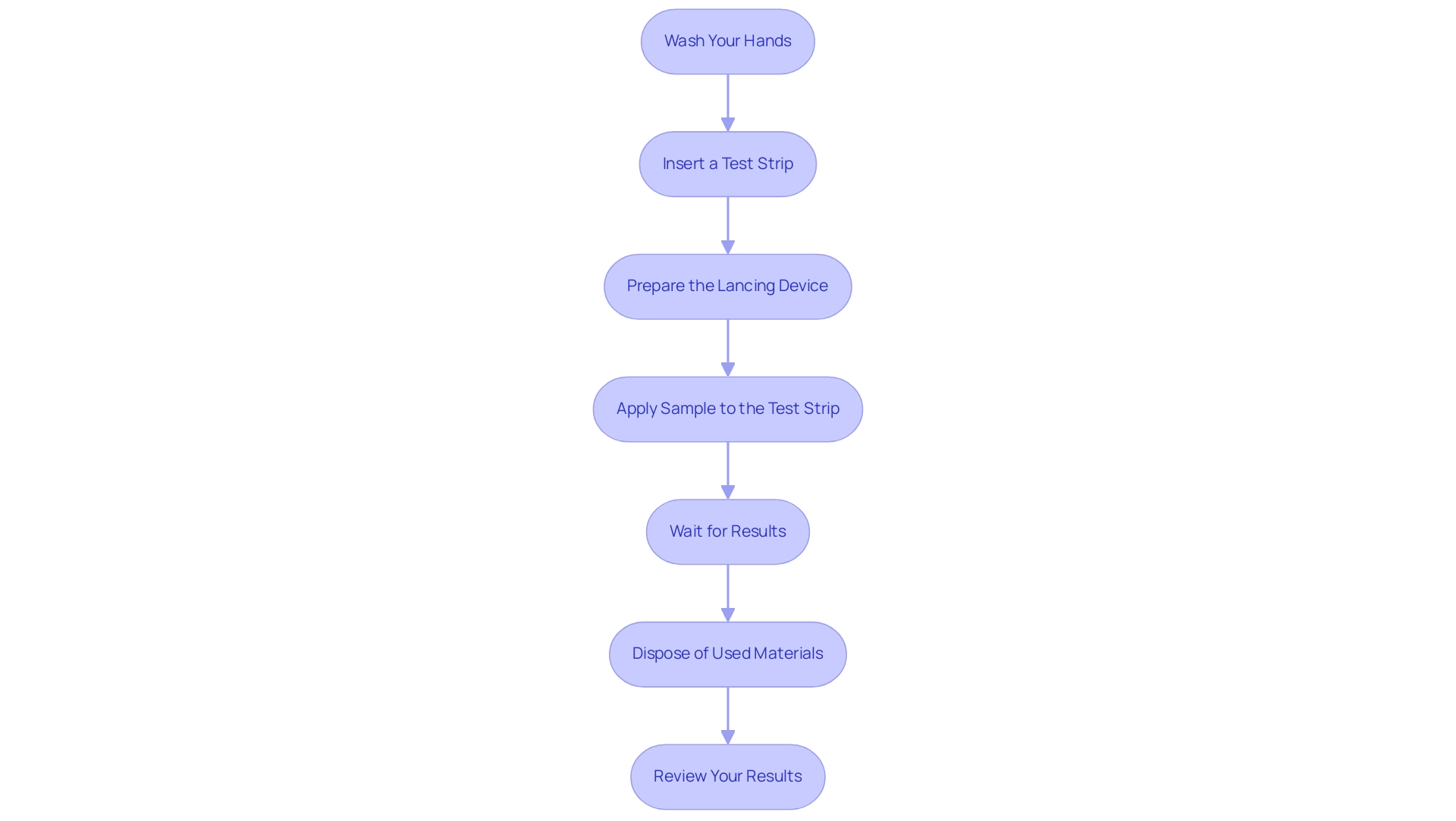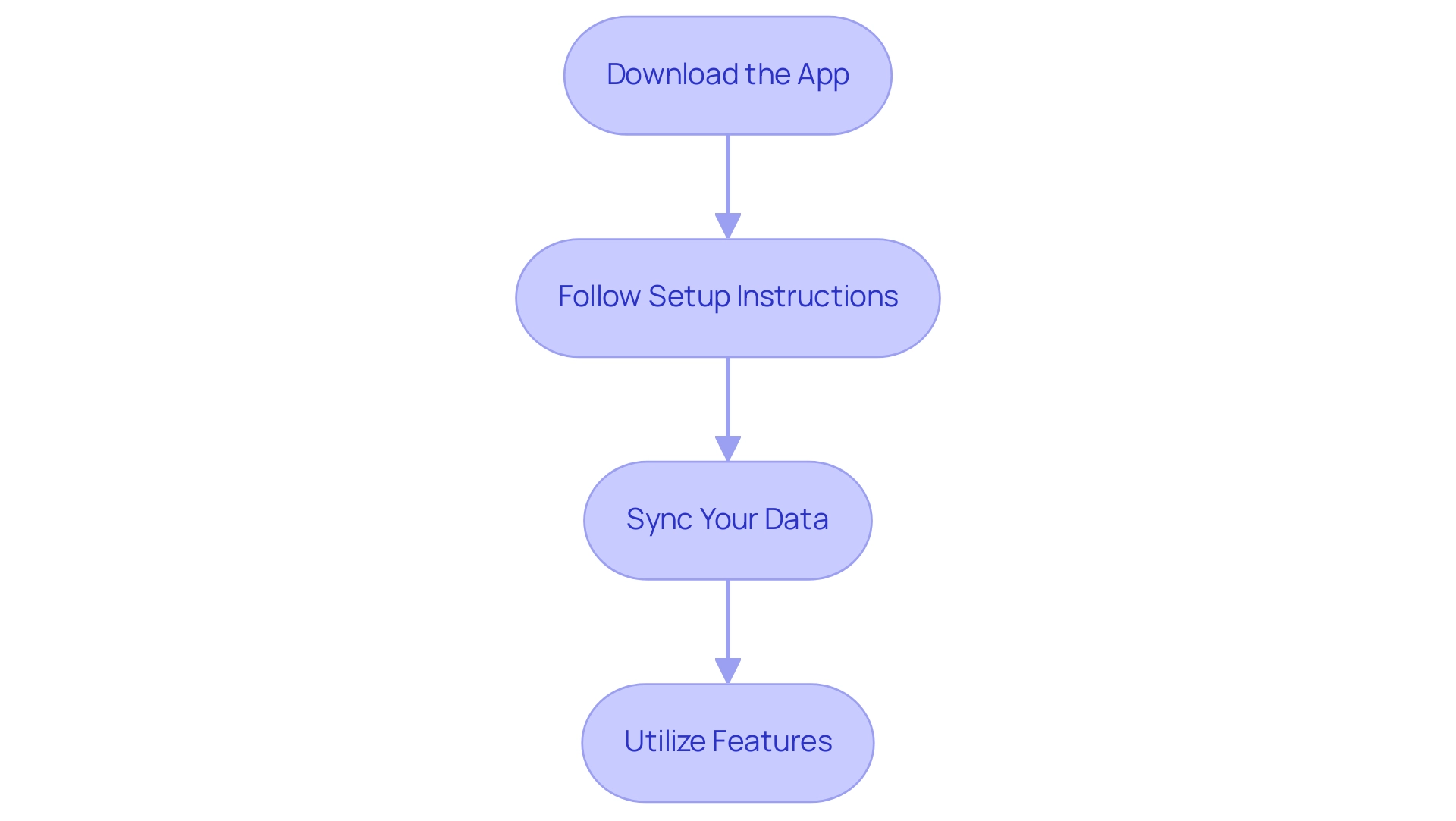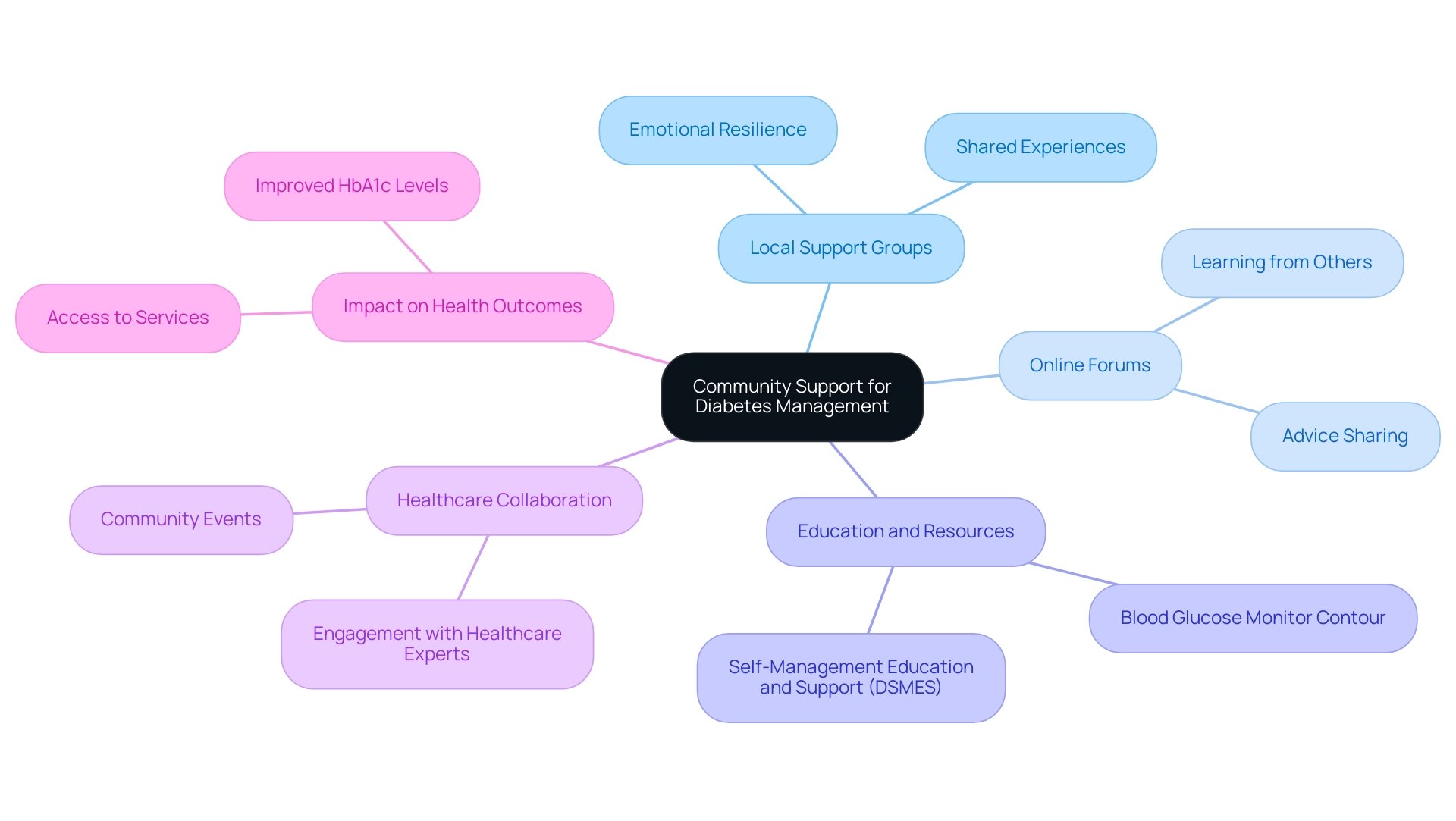Overview
Choosing and using a blood glucose monitor from the Contour series is crucial for effective diabetes management, as it allows individuals to track their blood sugar levels accurately and consistently. The article emphasizes that features such as user-friendly designs, rapid response times, and connectivity with health apps enhance usability, ultimately helping users maintain optimal glucose levels and reduce the risk of complications associated with diabetes.
Introduction
Managing diabetes effectively requires a multifaceted approach, with blood glucose monitoring at its core. T2DSolutions emerges as a vital resource hub, dedicated to aiding individuals with Type 2 and Type 3 diabetes in their management journey. This article delves into the significance of regular blood glucose monitoring, the features of the Contour Blood Glucose Monitoring Series, and guidance on selecting the right device. Additionally, it provides a step-by-step guide for using these monitors, explores the integration of technology through diabetes management apps, and emphasizes the importance of community support. By understanding these elements, individuals can take proactive steps towards better health outcomes and a more informed management of their condition.
The Importance of Blood Glucose Monitoring in Diabetes Management
Blood glucose monitoring using the blood glucose monitor contour is essential for effective control of the condition, and T2 Solutions is thrilled to present itself as a new resource center focused on assisting individuals with Type 2 and Type 3 conditions. This platform empowers individuals to meticulously track their blood glucose monitor contour, offering insights into how various factors—such as food intake, physical activity, and medication—impact their sugar levels. By maintaining a regular monitoring routine, patients can significantly reduce the risk of complications such as hypoglycemia or hyperglycemia, thereby safeguarding their overall health and wellbeing.
Furthermore, T2DSolutions will provide a variety of resources, including:
- Educational materials
- Community support forums
- Expert consultations
to assist users in navigating their health management journey. Inadequate monitoring of sugar levels can result in serious repercussions, adding to the shocking estimated expenses of identified health conditions related to diabetes in the United States, which amounted to $413 billion in 2022. This emphasizes the essential requirement for individuals to prioritize consistent and precise tracking of their sugar levels.
As M.E.L., the guarantor of this work, emphasizes, 'the integrity of the data and its analysis is fundamental to understanding the impact of monitoring on the control of diabetes-related conditions.' Additionally, the case study titled 'Limitations and Future Directions' acknowledges the need for further studies on continuous sugar monitoring (CGM) systems and their long-term effectiveness, underscoring the importance of ongoing research in this area. Ultimately, effective management of the condition relies on using a blood glucose monitor contour to monitor sugar levels, leading to enhanced health results and a decreased chance of related complications, and T2 Solutions is here to assist you on this journey.
Key Features of the Contour Blood Glucose Monitoring Series
The blood glucose monitor contour series is known for several key features that significantly enhance its usability and effectiveness for managing blood sugar. Each monitor is equipped with a large, easily readable display, enabling users to quickly view their results. The rapid response time for glucose readings ensures that patients can efficiently manage their blood sugar levels, which is critical as modification of antidiabetic treatment is essential if blood sugar levels drop below 3.9 mmol/L (70 mg/dL).
Furthermore, advanced technology integrated into these devices eliminates the need for coding, streamlining the testing process. User-friendly interfaces are designed to simplify operation, making the monitors accessible even for those who may not be technologically savvy. Notably, many models offer customizable reminders for testing, which aids users in maintaining a consistent monitoring routine.
Collectively, these features contribute to the high user satisfaction ratings for the blood glucose monitor Contour, making it a preferred option for individuals managing blood glucose levels. Moreover, professional insights highlight the benefits of the Contour series, acknowledging its importance in enabling patients to take charge of their glycemic control effectively. It is important to note that effective management of the condition requires a multidisciplinary approach involving various healthcare professionals, as highlighted in the case study titled 'Glycemic Care in Clinical Settings,' which emphasizes the role of capillary testing and the significance of education on diet, exercise, and medication adherence.
How to Choose the Right Contour Monitor for Your Needs
As part of the launch of Td Solutions, an essential resource hub for Type 2 and Type 3 health education, it is vital to select the appropriate blood glucose monitor contour. It is important to assess your lifestyle, testing frequency, and any specific health concerns that may influence your choice. According to the American Diabetes Association, a target sugar level of less than 180 mg/dL one to two hours after the beginning of a meal is recommended, which can guide you in choosing a monitor that helps you stay within this range.
Important features to evaluate include:
- Memory capacity for storing previous readings
- User-friendliness
- Capability to connect with mobile applications for comprehensive tracking
For those who travel frequently, opting for a compact model that is both easy to transport and utilize is advisable. Furthermore, it is crucial to engage with your healthcare provider to identify which features will best align with your diabetes management strategy.
As one user shared, 'I woke up in the middle of the night to my CGM alerting me about a severe low sugar level...'... I didn’t experience any of my typical symptoms of low blood sugar. This highlights the importance of reliable monitoring devices in managing diabetes effectively. Additionally, T2DSolutions will provide educational materials and community support initiatives to help users understand their options better.
Research indicates that thoughtful device selection, especially regarding the blood glucose monitor contour, can substantially enhance self-management outcomes, and understanding factors like hematocrit levels and certain drugs that can impact glucose meter accuracy, as noted in the case study on handling out-of-range specimens, underscores the importance of making an informed choice.
Step-by-Step Guide to Using Your Contour Blood Glucose Monitor
To utilize your blood glucose monitor contour effectively, adhere to the following step-by-step protocol:
- Wash Your Hands: Begin by thoroughly washing your hands to eliminate any contaminants that could affect the accuracy of your reading.
- Insert a Test Strip: Carefully insert a test strip into the blood glucose monitor contour, following the manufacturer's instructions to ensure proper alignment and functionality.
- Prepare the Lancing Device: Utilize a lancing device to obtain a sample, adjusting the depth setting to a comfortable level to minimize discomfort during the procedure.
- Apply Sample to the Test Strip: Gently touch the drop of fluid to the designated area on the test strip until the meter confirms the sample has been registered.
- Wait for Results: The blood glucose monitor contour will show your glucose level within seconds. If necessary, document the result for future reference. It's important to remember that effective monitoring, particularly with a blood glucose monitor contour, can significantly impact your overall health, as this condition has considerable socioeconomic implications.
- Dispose of Used Materials: Safely dispose of the used test strip and lancet, adhering to local regulations to ensure environmental safety.
- Review Your Results: Take time to analyze your readings from the blood glucose monitor contour, as understanding how your lifestyle choices affect your glucose levels is crucial for effective health oversight. This reflective practice can help identify patterns and inform future decisions regarding diet and activity, ultimately aiding in the control of your condition.
For instance, utilizing the Cumulative Variability Grid Analysis (CVGA) can help visualize your glycemic control over time, categorizing your results into defined zones and identifying areas for improvement. As noted by Boris Kovatchev, Ph.D., "We believe that such displays would provide valuable information to physicians and patients in a condensed, easy-to-interpret format—information that otherwise may remain lost in the complexity of the CGM data stream." Additionally, recent findings indicate that the spread of blood glucose data is larger before treatment, reflecting the importance of effective monitoring practices in managing this condition.
For further support and resources, T2DSolutions offers a comprehensive hub for education and community support. After following these monitoring steps, consider exploring the educational resources available on T2DSolutions to enhance your understanding of health control and connect with others on a similar journey.

Leveraging Technology: Connecting Your Contour Monitor to Diabetes Management Apps
at&t Solutions, we are dedicated to providing comprehensive resources for managing blood sugar levels. Numerous blood glucose monitor contour devices are designed to effortlessly link with health tracking applications, enabling users to efficiently observe their blood glucose levels over time. To establish this connection, follow these steps:
- Download the App: Begin by installing the suitable health monitoring application on your smartphone or tablet. Common choices encompass Glooko, a platform for data tracking that enables users to record food and activity information, as well as others that work with Contour monitors.
- Follow Setup Instructions: Launch the app and adhere to the on-screen instructions to create your account and pair your monitor. This process typically involves selecting your device model and confirming the connection.
- Sync Your Data: Once paired, allow the app to sync data from your monitor. This synchronization provides valuable insights into your blood sugar trends, facilitating improved control of your diabetes.
- Utilize Features: Explore the app's features, which may include reminders for testing, dietary tracking, and customizable reports that can be shared with your healthcare provider. As highlighted by J.J.C., a specialist in blood sugar control, 'Integrating the blood glucose monitor contour with applications significantly improves care for those with diabetes, particularly when remote assistance is crucial.' This integration not only enhances user engagement but also enables a more proactive approach to managing one’s condition, aligning with findings that 58% of related apps include physical activity tracking features.
Furthermore, a recent case study revealed that only 19.6% of patients reported using such apps, with glucose diaries being the most favored feature. By utilizing these tools, users can gain a clearer understanding of their health journey. At&t Solutions, we strive to empower newly diagnosed individuals with the knowledge and resources essential for effective health oversight, ensuring that you receive the support required to flourish.

Building a Supportive Community for Diabetes Management
Creating a supportive community is essential for improving your management experience, and T2D Solutions, a new site coming soon, is here to act as your comprehensive resource for blood glucose monitor contour in Type 2 and Type 3 health management. Participating in local support groups or online forums offers chances to share experiences, seek advice, and learn from others who encounter similar challenges. Research indicates that individuals who participate in community support initiatives often experience better health outcomes; for instance, a 1% reduction in HbA1c levels correlates with every additional 23.6 hours of engagement in support activities.
At T2D Solutions, we empower individuals and families through education and community support, assisting them in navigating their health journey. Moreover, collaborating with healthcare experts and participating in community events can significantly improve your understanding and strategies regarding blood glucose monitor contour. It is essential for healthcare providers to increase awareness and utilization of Self-Management Education and Support (DSMES) services, which incorporate tools like the blood glucose monitor contour to play a structured role in managing the condition.
Additionally, health policy and reimbursement processes significantly impact access to these crucial services, including the blood glucose monitor contour, as highlighted in the case study on reimbursement for education services. Dr. V. S. Ajgaonkar, a respected diabetologist, emphasizes the importance of community support, stating,
Doctor, why our child?
highlighting the necessity for a person-centered approach in managing blood sugar conditions.
By actively seeking out and participating in support groups for managing the condition, along with using a blood glucose monitor contour, you can foster emotional resilience and gain practical strategies, ultimately creating a holistic framework for living well with the disease. Current trends in support communities for individuals with chronic conditions also reflect a growing emphasis on personalized care and the integration of technology, including tools like the blood glucose monitor contour, further enhancing the assistance available to those managing their health. Subscribe to T2D Solutions to stay updated and receive valuable resources as we continue to develop our platform dedicated to empowering diabetes management and hosting upcoming events.

Conclusion
Effective management of diabetes hinges on the consistent monitoring of blood glucose levels, a practice that can significantly improve health outcomes and reduce the risk of complications. T2DSolutions stands out as an invaluable resource, providing individuals with Type 2 and Type 3 diabetes essential tools and support. The importance of selecting the right monitoring device, such as the Contour Blood Glucose Monitoring Series, cannot be overstated. With user-friendly features and the ability to connect to diabetes management apps, these devices empower users to take control of their health.
Following a structured approach to using these monitors, as outlined in the step-by-step guide, ensures accurate readings and informed decision-making about lifestyle choices. Additionally, leveraging technology through apps enhances the monitoring experience, providing deeper insights into blood glucose trends and facilitating better communication with healthcare providers.
Community support plays a crucial role in diabetes management. Engaging with support groups and educational initiatives fosters a sense of belonging and provides practical strategies for overcoming challenges. By prioritizing blood glucose monitoring, utilizing advanced technology, and building a supportive network, individuals can navigate their diabetes journey more effectively, ultimately leading to improved health and quality of life.
Frequently Asked Questions
Why is blood glucose monitoring important for individuals with Type 2 and Type 3 conditions?
Blood glucose monitoring is essential for effective control of these conditions as it helps individuals track how factors like food intake, physical activity, and medication impact their sugar levels, reducing the risk of complications such as hypoglycemia or hyperglycemia.
What resources does T2 Solutions provide for individuals managing their health?
T2 Solutions offers a variety of resources including educational materials, community support forums, and expert consultations to assist users in navigating their health management journey.
What are the consequences of inadequate monitoring of sugar levels?
Inadequate monitoring can lead to serious health repercussions and contributes to the high economic burden associated with diabetes-related health conditions, which amounted to $413 billion in the United States in 2022.
What features enhance the usability of the blood glucose monitor Contour?
The Contour series features a large, easily readable display, rapid response time for glucose readings, no need for coding, user-friendly interfaces, and customizable reminders for testing, all contributing to high user satisfaction.
How does the Contour monitor assist in managing blood sugar levels?
The Contour monitor allows patients to efficiently manage their blood sugar levels with quick readings, which is critical for modifying antidiabetic treatment if blood sugar levels drop below 3.9 mmol/L (70 mg/dL).
What is emphasized in the case study titled 'Glycemic Care in Clinical Settings'?
The case study highlights the importance of a multidisciplinary approach involving various healthcare professionals, capillary testing, and education on diet, exercise, and medication adherence for effective management of diabetes.
What is the significance of ongoing research in continuous sugar monitoring (CGM) systems?
Ongoing research is important to understand the long-term effectiveness of CGM systems, as noted in the case study 'Limitations and Future Directions'.



